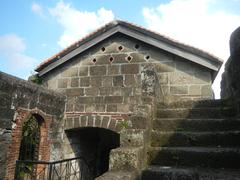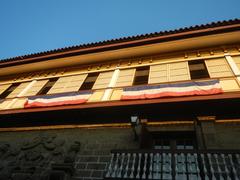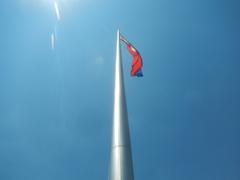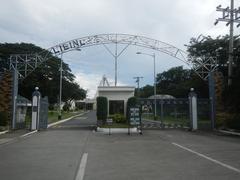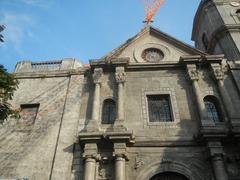Visiting the Rizal Monument in Taguig: Hours, Tickets, and History
Date: 18/07/2024
Introduction
Table of Contents
- [Introduction](#introductionintroduction)
- [Historical Facts and Significance](#historical-facts-and-significancehistorical-facts-and-significance)
- [Early Years and Inspiration](#early-years-and-inspirationearly-years-and-inspiration)
- [The Design Competition and its Winner](#the-design-competition-and-its-winnerthe-design-competition-and-its-winner)
- [Construction and Unveiling](#construction-and-unveilingconstruction-and-unveiling)
- [Guardianship of Rizal’s Remains](#guardianship-of-rizals-remainsguardianship-of-rizals-remains)
- [Practical Visitor Information](#practical-visitor-informationpractical-visitor-information)
- [Visiting Hours and Tickets](#visiting-hours-and-ticketsvisiting-hours-and-tickets)
- [Travel Tips](#travel-tipstravel-tips)
- [Special Events and Guided Tours](#special-events-and-guided-toursspecial-events-and-guided-tours)
- [Photographic Spots](#photographic-spotsphotographic-spots)
- [Enduring Symbolism and Legacy](#enduring-symbolism-and-legacyenduring-symbolism-and-legacy)
- [FAQs](#faqsfaqs)
- [Conclusion](#conclusionconclusion)
Historical Facts and Significance
Early Years and Inspiration
The idea for a monument honoring Rizal emerged soon after his execution on December 30, 1898. The execution, a pivotal moment in Philippine history, ignited a firestorm of nationalist sentiment, solidifying Rizal’s image as a martyr for the cause of freedom. On December 23, 1898, just days after the Philippines declared independence from Spain, Emilio Aguinaldo, the president of the revolutionary government, decreed that December 30th would be celebrated annually as a day of national mourning in Rizal’s honor. This decree laid the groundwork for the monument’s creation, reflecting the profound impact of Rizal’s life and death on the Filipino psyche.
The Design Competition and its Winner
In 1905, the Philippine government, then under American administration, passed Act No. 137, authorizing the construction of a monument in Rizal’s honor. The act stipulated that the monument be erected on the Luneta, the very site of Rizal’s execution. To ensure a design befitting Rizal’s stature, the committee opted for an international design competition. Architects and sculptors from across the globe submitted their proposals, each vying to capture the essence of Rizal’s legacy. The winning design came from the renowned Swiss sculptor Richard Kissling, known for his poignant and powerful monuments. Kissling’s design, titled “Motto Stella” (Guiding Star), resonated deeply with the selection committee. It depicted Rizal in a dignified stance, his overcoat draped over his shoulder, symbolizing his unwavering courage and intellectual prowess.
Construction and Unveiling
The cornerstone for the Rizal Monument was laid on December 30, 1910, marking the 12th anniversary of Rizal’s execution. The construction, however, was a complex and lengthy process, spanning several years. The monument’s base and obelisk were crafted from granite quarried from Binangonan, Rizal, while the bronze statue of Rizal and allegorical figures were cast in Switzerland. These materials, sourced both locally and internationally, symbolized the global reach of Rizal’s ideals. Finally, on December 30, 1913, the Rizal Monument was unveiled to the public. The grand ceremony, attended by a massive crowd, marked a pivotal moment in Philippine history, solidifying the monument’s status as a national shrine.
Guardianship of Rizal’s Remains
The Rizal Monument is not just a symbolic tribute; it houses the hero’s remains. Interred beneath the monument’s base, Rizal’s tomb serves as a constant reminder of his sacrifice and the price of freedom. The presence of Rizal’s remains elevates the monument’s significance, transforming it into a pilgrimage site for Filipinos and visitors alike. It’s a place of reflection, remembrance, and a testament to the enduring power of Rizal’s legacy.
Practical Visitor Information
Visiting Hours and Tickets
The Rizal Monument is open to the public daily from 6:00 AM to 10:00 PM. Admission is free, making it an accessible destination for everyone. However, guided tours may have associated costs.
Travel Tips
- Best Time to Visit: Early mornings or late afternoons are ideal to avoid the midday heat.
- Accessibility: The park is wheelchair accessible, and there are ramps and pathways for ease of movement.
- Nearby Attractions: Don’t miss other historical sites such as the National Museum, Manila Ocean Park, and Intramuros.
Special Events and Guided Tours
Special events, such as wreath-laying ceremonies, are often held on Rizal Day (December 30) and other national holidays. Guided tours are available and provide in-depth historical context, enhancing your visit.
Photographic Spots
The monument itself is a popular spot for photography, especially during sunrise and sunset. The surrounding park also offers beautiful landscapes and scenic views.
Enduring Symbolism and Legacy
The Rizal Monument stands as a powerful symbol of Philippine nationalism, embodying the values Rizal championed—education, freedom, and social justice. The monument’s design elements are laden with symbolism. The three stars represent Luzon, Visayas, and Mindanao, the three major island groups of the Philippines, signifying Rizal’s vision of a unified nation. The allegorical figures surrounding the obelisk represent education, family, and labor, reflecting Rizal’s belief in the transformative power of these elements.
The Rizal Monument’s significance extends beyond its physical presence. It serves as a constant reminder of the struggle for independence, the importance of education, and the pursuit of social justice. It’s a place where Filipinos commemorate their history, celebrate their identity, and draw inspiration from their national hero.
FAQs
Q: What are the Rizal Monument visiting hours?
A: The monument is open daily from 6:00 AM to 10:00 PM.
Q: Are there any tickets required to visit the Rizal Monument?
A: Admission is free, though guided tours may have associated costs.
Q: What nearby attractions can I visit?
A: Nearby attractions include the National Museum, Manila Ocean Park, and Intramuros.
Q: Is the Rizal Monument wheelchair accessible?
A: Yes, the park is wheelchair accessible with ramps and pathways.

